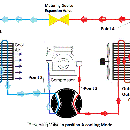Introduction: Welding Fixture Clamps
I needed some fixture clamps for my new welding table, but they are $30+ per clamp. Many others have shown how to make DIY fixture clamps from Harbor Freight quick clamps, but they all require cutting or grinding bolts. I wanted a cheap, quick way to make fixture clamps. For this project, I use quick clamps ($4, Harbor Freight) and 5/8" x 2" clevis pins ($2.75, eBay).
The quick clamps come in various lengths, choose any size you like. I used 6" and 12" clamps.
I found a pack of nine 5/8" clevis pins on eBay for $25. I chose clevis pins because they had no threads (unlike bolts) but have a head to keep them from falling through the fixture holes in the table. My table, like most, have 16mm (0.630") fixture holes. 5/8" (0.625") is just the right size to easily slip into the 16mm fixture holes but lock in once the offset clamping force is applied. The 5/8" clevis pins are actually a little undersized (0.620") so they tilt under load more than I would like, but they hold. And they're cheap.
Step 1: Disassemble Clamp
The fixed end of the clamp must be removed as that is where the clevis pin will be welded. To remove it, grind off the head of the pin securing the fixed end (circled in red), then drive it out with a punch. Next, drive the clamp bar out of the fixed end.
For a bonus project, save the fixed end and remove the detent (circled in red) on the other end of the bar that keeps the moveable end from coming off. See the last step for details.
Step 2: Prep for Welding
Prep the bar and clevis pin for welding by removing any finish on the metal. Use a wire brush or relatively fine sandpaper.
Step 3: Weld Bar to Clevis Pin
Center the bar on the head of the clevis pin. While not critical, align the bar's centerline axis with the clevis pin. It looks much better if everything is straight and centered.
Tack weld the bar onto the clevis pin. Check for straightness. If all looks good, weld both sides.
Step 4: Clamp Something
Try out your new clamps! Put them in a fixture hole then tighten them down. It's not complicated.
Step 5: Put the Fixed End Back on (optional)
Bonus project: Put the fixed end back on the bar and use the clamp in its original configuration for normal clamping needs!
To switch between "configurations", slide the movable end off of the bar (be careful not to lose the spring!), slide the fixed end (removed previously) down to the clevis pin, then put the movable end back on. You will need to use a file to open up the slot on the fixed end so that it will slide onto the bar.
Enjoy your dual purpose clamps!













